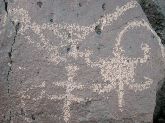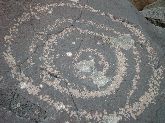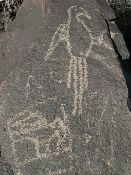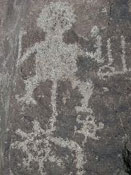Rock Art
Posted by Claudia on Feb 13th 2014
Throughout ancient history man has carved or painted on rocks and caves leaving traces of his time and world. Here in the Southwest United States, rock paintings and petroglyphs are known to have a history of about 3,000 years of artistic endeavor by Native American Indians.
Rock paintings are usually found on light-colored surfaces such as cliffs or beneath overhangs. Colors were determined by resources available or by rituals. Petroglyphs are more common throughout the Southwest and are made by pecking, carving or scratching into the surface of rock containing desert varnish. Rock or desert varnish is a layer of minerals that become attached to a rock’s surface in dry climates. When certain airborne minerals settle on a rock’s surface, commonly highly patinated sandstone or basalt rocks or cliffs, a dark layer is formed. The result of pecking or carving into the dark surface is a contrast with the underlying light rock.
|
|
|
| Bird, Turtle, & Dragonfly | Spiral of Life |
In the Southwest, pertroglyph styles are often similar in a certain time period, geographic area or Native American tribe.
- Archaic Style – All the Southwest approx. 5000 BC – 300 AD
- Freemont Style – Central and Southern Utah 500 – 1400 AD
- Anasazi Style – Four Corners Region where Arizona, Utah, Colorado and New Mexico. 300 – 1300 AD
- Hohokam Style – Central and Southern Arizona 300 – 1400 AD
- Rio Grande Style – Central and Northern New Mexico 1300 AD to present
Rock art is important in understanding the sacred dimension and cultural practices of the past. In many cases rock art is a visual communication and documentation system that can be divided into four styles. Representational art which depicts life-forms such as human figures, spiritual beings, birds, snakes and other four-legged animal forms. Abstract art usually represents no life form or resemblance to the real world and often the meaning has been lost. Native Americans sometimes recognize purposes and meanings of petroglyphs for designs that are apart of their tribal heritage today.
|
|
|
| Macaw | Possible Birth Scene & Turtle |
Petroglyphs do not stand for a certain word or sound in a language but they convey meaning. Petroglyphs were usually made in specific places of cultural significance for a certain reason. Some petroglyphs recorded history and events such as migrations of a clan or a hunt and even Europeans on horseback. Some Native Americans had a person designated to monitor the sun’s position and other sky observations. Petroglyphs of deer, bighorn sheep and other large game animals are frequent in rock art and possibly were used to encourage fertility of the animals or to indicate good hunting sites. Some petroglyphs were made to mark a trail, indicate water, territories or some other cultural or natural feature. Also, some religious or other supernatural beings in rock art have been identified by Native Americans or researchers. Shaman trances are often depicted with figures surrounded by dots or as human-birds. Petroglyphs may also illustrate legends or characters in stories.
Rock art provides evidence of trade, history and cultural communication in ancient times. Many of the designs that are seen today in Native American Indian jewelry are found in the rock art of their ancestors.




